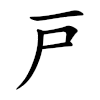戸
| ||||||||
Translingual
| Stroke order | |||
|---|---|---|---|
 | |||
| Traditional | 戶 |
|---|---|
| Shinjitai | 戸 |
| Simplified | 户 |
Han character
戸 (Kangxi radical 63, 戶+0, 4 strokes, cangjie input 一尸 (MS) or 難一尸 (XMS), composition ⿱一尸)
References
- Kangxi Dictionary: not present, would follow page 414, character 32
- Hanyu Da Zidian (first edition): volume 3, page 2257, character 1
- Unihan data for U+6238
Chinese
| For pronunciation and definitions of 戸 – see 戶 (“door; family; household; etc.”). (This character is a variant form of 戶). |
Japanese
Readings
Etymology 1
| Kanji in this term |
|---|
| 戸 |
| と Grade: 2 |
| kun’yomi |
| Alternative spellings |
|---|
| 戶 (kyūjitai) 門 |
From Old Japanese, from Proto-Japonic *to. According to Beckwith (2004), related to the Kara word dol (/dor/, “door”).
Etymology 2
| Kanji in this term |
|---|
| 戸 |
| こ Grade: 2 |
| kan’on |
| Alternative spelling |
|---|
| 戶 (kyūjitai) |
Sino-Japanese, from Middle Chinese 戶 (MC huX).
Noun
戸 • (ko)
- houses; apartments
- door
- The smallest administrative division under the ritsuryō system of governance.
References
- Matsumura, Akira, editor (2006), 大辞林 [Daijirin] (in Japanese), Third edition, Tōkyō: Sanseidō, →ISBN
- NHK Broadcasting Culture Research Institute, editor (1998), NHK日本語発音アクセント辞典 [NHK Japanese Pronunciation Accent Dictionary] (in Japanese), Tōkyō: NHK Publishing, →ISBN
This article is issued from Wiktionary. The text is licensed under Creative Commons - Attribution - Sharealike. Additional terms may apply for the media files.